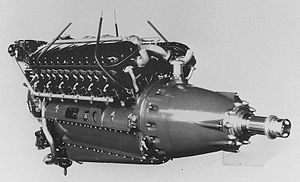Allison V-1710
| V-1710 | |
|---|---|
 |
|
| Allison V-1710 C-series engine | |
| Type | Liquid-cooled V-12 piston engine |
| Manufacturer | Allison Engine Company |
| First run | 1930 |
| Major applications |
Bell P-39 Airacobra Curtiss P-40 Warhawk Lockheed P-38 Lightning North American P-51 Mustang |
| Number built | 69,305 |
| Developed into | Allison V-3420 |
The Allison V-1710 aircraft engine designed and produced by the Allison Engine Company was the only US-developed V-12 liquid-cooled engine to see service during World War II. Versions with a turbocharger gave excellent performance at high altitude in the twin-engined Lockheed P-38 Lightning, and turbosuperchargers were fitted to experimental single-engined fighters with similar results.
The United States Army Air Corps (USAAC) preference for turbochargers early in the V-1710's development program meant that less effort was spent on developing suitable mechanically-driven, centrifugal superchargers for the Allison V-12 design, as other V-12 designs from friendly nations like the British Rolls-Royce Merlin were already using.
When smaller-dimensioned or lower-cost versions of the V-1710 were desired, they generally had poor performance at higher altitudes. The V-1710 nevertheless gave excellent service when turbocharged, notably in the P-38 Lightning, which accounted for much of the extensive production run.
The Allison Division of General Motors began developing a ethylene glycol-cooled engine in 1929 to meet a USAAC need for a modern, 1,000 hp (750 kW), engine to fit into a new generation of streamlined bombers and fighters. To ease production the new design could be equipped with different propeller gearing systems and superchargers, allowing a single production line to build engines for various fighters and bombers.
The United States Navy (USN) hoped to use the V-1710 in its rigid airships Akron and Macon, but both were equipped with German-built Maybach VL-2 engines as the V-1710 was still in testing when the Macon was lost in February 1935 (the Akron having been lost in April 1933). The USAAC purchased its first V-1710 in December 1932. The Great Depression slowed development, and it was not until December 14, 1936 that the engine next flew in the Consolidated XA-11A testbed. The V-1710-C6 successfully completed the USAAC 150 hour Type Test on April 23, 1937 at 1,000 hp (750 kW), the first engine of any type to do so. The engine was then offered to aircraft manufacturers where it powered the prototype Curtiss XP-37s. All entrants in the new pursuit competition were designed around it, powering the Lockheed P-38, Bell P-39 and Curtiss P-40. When war material procurement agents from the United Kingdom asked North American Aviation to build the P-40 under license, NAA instead proposed their own improved aircraft design, using the V-1710 in their NA-73.
...
Wikipedia
